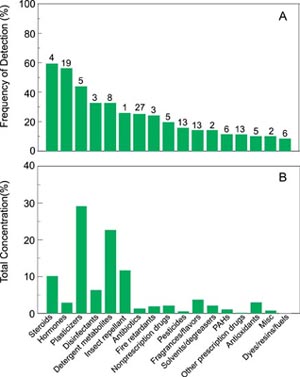
Although select research has been conducted on OWC transport to ground water, no information, however, was previously available on a national scale in the United States. The U.S. Geological Survey, as part of a continuing effort to collect baseline information on the occurrence of pharmaceuticals, hormones and other OWCs in water resources of the United States, collected and analyzed 72 ground water samples derived from two separate studies across 24 states and Puerto Rico during 2000 and 2001.
One study, a national reconnaissance of OWCs in ground water, sampled 47 sites suspected to be susceptible to contamination from either animal or human wastewaters. A second study sampled 25 ground water sources of public drinking water supply. These sites were selected based on prior knowledge or potential to be influenced by wastewater inputs and were collected prior to drinking water treatment.
The results from this study confirm and expand results from previous studies in the United States and elsewhere and document that many of the targeted OWCs have sufficient persistence and mobility to be transported to ground water in detectable quantities in a variety of climatic and hydrogeologic settings with potential wastewater sources across the nation.

Site Selection and Sampling
In 2000, ground water samples were collected from 47 sites in variety of climatic and hydrogeologic settings thought to be susceptible to contamination from either animal or human wastewaters (i.e. down gradient of a landfill, unsewered residential development or animal feedlot). In 2001, ground water samples were collected from 25 sites as part of the national reconnaissance of untreated drinking water sources. These sites were selected because of known or potential influence by wastewater inputs. These samples were collected prior to water treatment (i.e., at the well head) and provide insight on the potential for the persistence of compounds as they are transported from areas near sources to drinking-water intakes.
Methods and Results
Four analytical methods were used to determine the environmental extent of 134 OWCs in the 72 ground water samples. The analyzed compounds can be divided into 17 groups based on their primary use and include antibiotics, prescription drugs, nonprescription drugs, steroids, personal-care products, products of oil use and combustion, and other extensively used chemicals.At least one OWC was found in 93 percent of the sites sampled (67 of 72). Mixtures were common, with more than one compound being detected at 53 of 72 sites. The maximum number of compounds detected at any one site was 21, and the median number of compounds detected was 3. Measured concentrations were generally low, with 24 of 72 sites (four were sources of drinking water) having a total OWC concentration greater than 1 µg/L. Five of 72 sites had a total OWC concentration greater than 5 µg/L.
Of the 134 OWCs measured, 77 were detected in at least one sample. The detected compounds represent a wide range of uses and origins. Twenty human and veterinary antibiotics, 11 prescription drugs, 24 industrial and wastewater products and two hormones were not detected in any of the ground water samples analyzed. The five most frequently detected compounds were cholesterol (a plant and animal steroid), bisphenol A (used in manufacturing of polycarbonate resins, antioxidant, flame retardant), estriol (reproductive hormone), N,N-diethytoluamide (DEET, used in insect repellant), and 4-nonylphenol monoethoxylate (a nonionic detergent metabolite). Some of these OWCs have been previously noted to be frequently detected in ground water.
Only three of the 17 major contaminant groups had a detection frequency greater than 40 percent: steroids, hormones and plasticizers (see Figure 2A). Comparing the frequency of detection to percent of total measured OWC concentration (Figure 2B) shows that four groups (plasticizers, detergent metabolites, insect repellent and steroids) contributed almost 75 percent of the total measured concentrations.
These results document that OWCs have sufficient persistence and mobility to be transported to ground water at detectable quantities in the nation's ground water over a variety of climatic and hydrogeologic settings. It currently is unknown whether deleterious effects to human and ecologic health may result from exposure to individual OWCs or mixtures of OWCs at the concentrations determined for this study.
This information is being used to develop long-term research stratagies on emerging contaminants for the U.S. Geological Survey's Toxic Substance Hydrology Program, and also is a unique source of national-scale information for other researchers and decision-makers.
ND

Report Abusive Comment